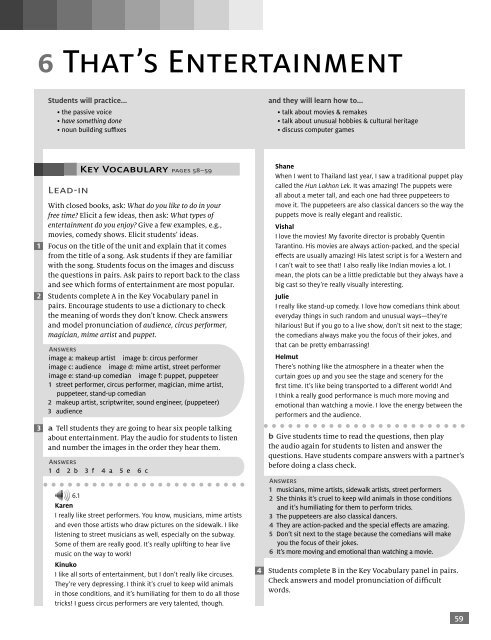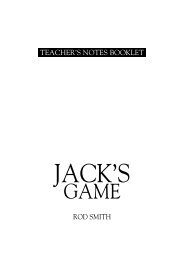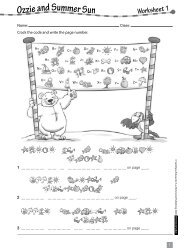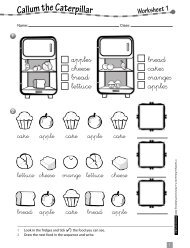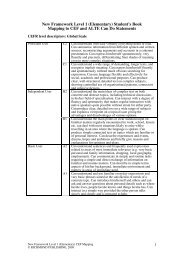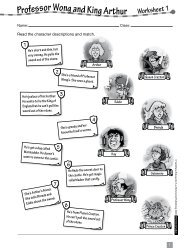That's Entertainment - Supadu
That's Entertainment - Supadu
That's Entertainment - Supadu
You also want an ePaper? Increase the reach of your titles
YUMPU automatically turns print PDFs into web optimized ePapers that Google loves.
6<br />
That’s <strong>Entertainment</strong><br />
Students will practice...<br />
• the passive voice<br />
• have something done<br />
• noun building suffixes<br />
and they will learn how to...<br />
• talk about movies & remakes<br />
• talk about unusual hobbies & cultural heritage<br />
• discuss computer games<br />
Lead-in<br />
Key Vocabulary pages 58–59<br />
With closed books, ask: What do you like to do in your<br />
free time? Elicit a few ideas, then ask: What types of<br />
entertainment do you enjoy? Give a few examples, e.g.,<br />
movies, comedy shows. Elicit students’ ideas.<br />
1 Focus on the title of the unit and explain that it comes<br />
from the title of a song. Ask students if they are familiar<br />
with the song. Students focus on the images and discuss<br />
the questions in pairs. Ask pairs to report back to the class<br />
and see which forms of entertainment are most popular.<br />
2 Students complete A in the Key Vocabulary panel in<br />
pairs. Encourage students to use a dictionary to check<br />
the meaning of words they don’t know. Check answers<br />
and model pronunciation of audience, circus performer,<br />
magician, mime artist and puppet.<br />
Answers<br />
image a: makeup artist image b: circus performer<br />
image c: audience image d: mime artist, street performer<br />
image e: stand-up comedian image f: puppet, puppeteer<br />
1 street performer, circus performer, magician, mime artist,<br />
puppeteer, stand-up comedian<br />
2 makeup artist, scriptwriter, sound engineer, (puppeteer)<br />
3 audience<br />
3 a Tell students they are going to hear six people talking<br />
about entertainment. Play the audio for students to listen<br />
and number the images in the order they hear them.<br />
Answers<br />
1 d 2 b 3 f 4 a 5 e 6 c<br />
6.1<br />
Karen<br />
I really like street performers. You know, musicians, mime artists<br />
and even those artists who draw pictures on the sidewalk. I like<br />
listening to street musicians as well, especially on the subway.<br />
Some of them are really good. It’s really uplifting to hear live<br />
music on the way to work!<br />
Kinuko<br />
I like all sorts of entertainment, but I don’t really like circuses.<br />
They’re very depressing. I think it’s cruel to keep wild animals<br />
in those conditions, and it’s humiliating for them to do all those<br />
tricks! I guess circus performers are very talented, though.<br />
Shane<br />
When I went to Thailand last year, I saw a traditional puppet play<br />
called the Hun Lakhon Lek. It was amazing! The puppets were<br />
all about a meter tall, and each one had three puppeteers to<br />
move it. The puppeteers are also classical dancers so the way the<br />
puppets move is really elegant and realistic.<br />
Vishal<br />
I love the movies! My favorite director is probably Quentin<br />
Tarantino. His movies are always action-packed, and the special<br />
effects are usually amazing! His latest script is for a Western and<br />
I can’t wait to see that! I also really like Indian movies a lot. I<br />
mean, the plots can be a little predictable but they always have a<br />
big cast so they’re really visually interesting.<br />
Julie<br />
I really like stand-up comedy. I love how comedians think about<br />
everyday things in such random and unusual ways—they’re<br />
hilarious! But if you go to a live show, don’t sit next to the stage;<br />
the comedians always make you the focus of their jokes, and<br />
that can be pretty embarrassing!<br />
Helmut<br />
There’s nothing like the atmosphere in a theater when the<br />
curtain goes up and you see the stage and scenery for the<br />
first time. It’s like being transported to a different world! And<br />
I think a really good performance is much more moving and<br />
emotional than watching a movie. I love the energy between the<br />
performers and the audience.<br />
b Give students time to read the questions, then play<br />
the audio again for students to listen and answer the<br />
questions. Have students compare answers with a partner’s<br />
before doing a class check.<br />
Answers<br />
1 musicians, mime artists, sidewalk artists, street performers<br />
2 She thinks it’s cruel to keep wild animals in those conditions<br />
and it’s humiliating for them to perform tricks.<br />
3 The puppeteers are also classical dancers.<br />
4 They are action-packed and the special effects are amazing.<br />
5 Don’t sit next to the stage because the comedians will make<br />
you the focus of their jokes.<br />
6 It’s more moving and emotional than watching a movie.<br />
4 Students complete B in the Key Vocabulary panel in pairs.<br />
Check answers and model pronunciation of difficult<br />
words.<br />
59
6.0–6.1<br />
Students then complete C in the Key Vocabulary panel.<br />
Check answers and model pronunciation of any difficult<br />
words. Ask students to use their dictionaries to check the<br />
meaning of the adjectives the speakers don’t use.<br />
Answers<br />
B 1 script 2 plot 3 performance 4 soundtrack 5 scene<br />
6 special effects 7 stage 8 part 9 cast 10 scenery<br />
a) movies: soundtrack, special effects<br />
b) theater: scenery, stage<br />
c) both: cast, part, performance, plot, scene, script<br />
C marked adjectives: action-packed (movies), depressing (circuses),<br />
hilarious (comedians), moving (the theater),<br />
predictable (plots), realistic (puppets), uplifting (music)<br />
positive (+) adjectives: action-packed, gripping, hilarious,<br />
intriguing, memorable, moving, realistic, uplifting<br />
negative (-) adjectives: depressing, predictable, unrealistic<br />
5 Read the exercise with the class. Explain atmosphere<br />
if necessary. Give students time to prepare their ideas<br />
individually before you put them into groups to compare<br />
their ideas. Ask groups to report back.<br />
Extra activity<br />
Refer students back to the images. Divide the class into<br />
pairs and ask them to imagine they are watching one of the<br />
performances in the images. Ask them to prepare a short<br />
conversation in which they discuss what they are watching<br />
without saying what it is. Monitor and help. Students can<br />
perform their conversations for the class, and the class can<br />
guess which image they are talking about.<br />
6.1<br />
Remakes page 60<br />
Speaking & Reading<br />
Lead-in<br />
Ask: What’s your favorite movie? Why? Elicit a range of<br />
answers and encourage students to agree and disagree<br />
with each other. Encourage students to use some of the key<br />
vocabulary from page 59.<br />
Background notes<br />
Akira Kurosawa (1910–1998) was a Japanese director who<br />
made over 30 movies and is considered to be one of the<br />
most influential movie directors of all time. Clint Eastwood<br />
is an American actor and movie director, known especially<br />
for his roles in westerns and as the tough, no-nonsense<br />
cop, Harry Callahan, in the Dirty Harry movies.<br />
1 Students look at and discuss the images in pairs. Ask pairs<br />
to report back and see if there is a class consensus.<br />
2 a Students read the article to answer the questions. Set a<br />
time limit to encourage students to read quickly.<br />
Answers<br />
1 A Fistful of Dollars and Yojimbo<br />
2 a new version of an existing movie<br />
b Read the chart with the class and make sure students<br />
understand everything. Preteach spaghetti western, a<br />
classic, satire and to sue. Students read the article again and<br />
complete the chart. Give students time to compare their<br />
answers in pairs before doing a class check.<br />
Answers<br />
Yojimbo A Fistful of Dollars<br />
1 Director Akiro Kurosawa Sergio Leone<br />
2 Lead actor Toshiro Mifune Clint Eastwood<br />
3 Release date 1961 1964<br />
4 Setting (date/place) Japan in 1860s 19th-century Mexico<br />
3 Students read the article again and answer the questions.<br />
Have them compare their answers with a partner’s before<br />
checking together in class.<br />
Answers<br />
1 They are safe options because they are easier to sell to<br />
the public as the original version is already known.<br />
2 In both, the hero is a loner who fights bandits but who is a<br />
man of honor as he spares innocent lives. However, Yojimbo is a<br />
comedy/satire set in Japan in the 1860s while A Fistful of Dollars is<br />
more serious and is set in nineteenth-century Mexico.<br />
3 The critics acclaimed the director’s cinematography but<br />
criticized the acting.<br />
4 He sued because Sergio Leone did not have permission to<br />
remake the movie.<br />
4 Ask the entire class the questions and elicit a range of<br />
answers. If students have not seen any remakes, ask<br />
them if they know any old movies they think could be<br />
successfully remade now.<br />
Grammar<br />
1 a&b Students complete the sentences with the verbs in<br />
the box. Students can then compare their answers in pairs<br />
before they check in the article. Check together in class and<br />
elicit that the verbs are all in the passive.<br />
Answers<br />
1 believed 2 remade 3 set 4 filmed 5 chosen<br />
2 a Answer the questions together in class, eliciting answers<br />
and explaining anything students do not understand.<br />
Answers<br />
1 sentence 2 (… by Sergio Leone)<br />
2 because it is obvious or we don’t know who is responsible<br />
4 believed – it is the opinion of people in general<br />
b Read the information in the Grammar panel together in<br />
class, then ask students to fill in the blanks with examples<br />
from 1a. Check answers.<br />
60
6.1–6.2<br />
Answers<br />
1 Yojimbo was remade by Sergio Leone as A Fistful of Dollars.<br />
2 It is set in the Old West…/… it was filmed in Spain./Clint<br />
Eastwood was chosen for the lead role.<br />
3 It is widely believed that a remake is a safe option for a<br />
moviemaker.<br />
The Passive Voice<br />
This grammar presentation focuses on the use of the<br />
passive. The exercises include examples of the present<br />
simple, past simple, present continuous and present perfect<br />
passive. With weaker classes, you might like to review the<br />
basic form of the passive: be + past participle. Students may<br />
still make mistakes with it, e.g., The movie was make in 1979.<br />
Mixed ability<br />
With weaker classes, give students more recognition<br />
practice by referring them back to the article on page 60<br />
and asking them to find more examples of the passive. Ask<br />
them to identify the tense and who is responsible for the<br />
action in each case. Ask them to say which are examples of<br />
reporting verbs.<br />
3 a Read the sentences together in class and do the first<br />
sentence as an example. Students report the opinions.<br />
Give students time to check their answers in pairs before<br />
checking together in class.<br />
Answers<br />
1 It is said that movies are the highest form of art.<br />
2 It is (widely) believed that computer games will have an<br />
enormous influence on movies in the future.<br />
3 It is claimed (by many movie fans) that modern moviemakers<br />
are obsessed with computer-generated effects.<br />
b Students discuss in pairs whether they agree with the<br />
opinions or not. Ask pairs to report back to the class.<br />
4 a Students read the review and rewrite the phrases.<br />
Have students compare answers in pairs before checking<br />
together in class.<br />
Answers<br />
1 It is believed that<br />
2 which was adapted from a little-known French film, Anthony<br />
Zimmer<br />
3 who is being chased by a mysterious woman (Angelina Jolie)<br />
4 The script was filled with surprises and action.<br />
5 It was directed by German moviemaker Florian Henckel von<br />
Donnersmarck.<br />
6 It was nominated for three Golden Globes.<br />
7 It is thought that it failed<br />
8 It has also been said<br />
Mixed ability<br />
With weaker classes, go over the movie review together<br />
in class and elicit the tense of each verb that needs to be<br />
rewritten before students complete the exercise.<br />
b Students discuss the questions in pairs. Ask pairs to<br />
report back on their discussions. Read the information in<br />
the Notice box with the class and tell students to remember<br />
this because they will need to use the passive in a writing<br />
task at the end of this unit.<br />
Speaking<br />
1 Divide the class into groups to discuss the questions.<br />
Monitor while students are talking and write down any<br />
common errors, but don’t interrupt them to correct errors.<br />
Ask groups to report back on their discussions and see if<br />
there is a class consensus. Correct any errors you noticed<br />
in a short feedback session at the end.<br />
6.2<br />
Lead-in<br />
Cultural Heritage page 62<br />
Ask: What are the traditional forms of entertainment in your<br />
country? Elicit a range of ideas, including types of music,<br />
dance, sports, etc. Focus on the title of the lesson and elicit<br />
or teach cultural heritage (the traditional cultural activities<br />
of a country or region). Ask: Do you think it is important to<br />
preserve your cultural heritage? Why? Elicit a range of answers.<br />
Speaking & Listening<br />
1 Students discuss the questions in groups. Ask groups to<br />
report back.<br />
2 a Students look at the images and discuss the questions in<br />
pairs. Ask pairs to report back, but don’t confirm or reject<br />
their ideas at this stage.<br />
b Play the audio for students to check their ideas and<br />
identify the two images that are talked about. Check<br />
answers and elicit any other information students picked<br />
up from the audio.<br />
Answers<br />
b a castell, from Catalonia in northern Spain<br />
c a didgeridoo, from Australia<br />
(Photo a shows tango dancers in Argentina and photo d shows<br />
people practicing kendo, a Japanese martial art.)<br />
6.2<br />
Part 1<br />
H = Host M = Miquela<br />
H: Welcome to our weekly spotlight show. Today the spotlight<br />
is on unusual hobbies and cultural heritage. Our first caller is<br />
Miquela from Barcelona. Hi, Miquela! Can you tell us about<br />
your hobby?<br />
M: Hi, Kevin. I’m a casteller. A castell in Catalan is a human tower!<br />
So castellers are people who construct human towers. It’s a<br />
popular tradition at festivals all over Catalonia. My father’s a<br />
casteller and throughout my childhood I wanted to be one,<br />
too. I was about... 16 when I started training with my local<br />
group. We had our photo taken last week and appeared in the<br />
local newspaper.<br />
61
6.2<br />
H: So how high are these towers, Miquela?<br />
M: They usually have four or five layers of people, but some have<br />
eight or nine! Surprisingly, accidents aren’t very common, but<br />
there are always ambulances standing by, just in case. There’s<br />
only been one fatality in the last 30 years.<br />
H: Well, it sounds amazing. And difficult!<br />
M: Yes, it takes years of training and practice. You need to be<br />
really strong, with great balance and lots of courage! You<br />
can’t show any weakness!<br />
H: And how old is the tradition?<br />
M: Er, it originated around the end of the 18th century in Valls,<br />
near the city of Tarragona.<br />
H: So how are the towers constructed exactly?<br />
M: They’re built in two stages. The bottom layer is built first. It’s<br />
called the pinya and it’s made up of men because they need<br />
to be really strong, you know, to support the rest of the tower.<br />
H: Of course!<br />
M: Once the castellers in the pinya think the base is strong<br />
enough, they give a signal. A band starts playing traditional<br />
music and the crowd goes completely silent; you can really<br />
feel the tension and excitement. The upper layers of the<br />
tower are built as quickly as possible so the strain on the<br />
bottom layer isn’t too much.<br />
H: And who climbs to the top?<br />
M: Usually very young children because they’re the lightest and<br />
most agile. The enxaneta is the person who climbs to the very<br />
top. The tower is complete when he or she raises four fingers.<br />
This is said to represent the four stripes on the Catalan flag.<br />
H: So what do you think the future of this tradition is, Miquela?<br />
M: Well, I think it has a very important future. The tradition is<br />
very strongly linked to Catalan identity. And it brings local<br />
communities together as well—family, friends and neighbors.<br />
H: Well, thank you for coming on the show, Miquela, and telling<br />
us about this fascinating tradition.<br />
Part 2<br />
H = Host, D = Daniel<br />
H: Now, on to our next guest, Daniel from Australia. So Daniel,<br />
tell us about your unusual hobby.<br />
D: Hi, Kevin. Well, I play a traditional Australian aboriginal<br />
instrument, the didgeridoo.<br />
H: OK. Can you tell us a little bit more about it?<br />
D: It’s believed to be the world’s oldest wind instrument. It<br />
originated in the north of Australia. The oldest records of<br />
Aboriginals playing the didgeridoo date back 2,000 years.<br />
H: That’s incredible. So when did you start playing it, Daniel?<br />
D: Well, when I was a kid we lived in the Northern Territories<br />
of Australia and I was always fascinated by the sound of this<br />
instrument. So I started playing when I was 13.<br />
H: And is it difficult to play?<br />
D: No, not at all. You can learn to play a basic note in like, two<br />
minutes!<br />
H: And what’s the instrument made of?<br />
D: It’s made of the trunk or branches of the eucalyptus tree,<br />
which is native to Australia.<br />
H: And is the instrument made by Australian Aboriginals?<br />
D: Well, actually, 99.9% of didgeridoos on the market are not<br />
made by Aboriginals. But I had mine made especially for me<br />
by an Australian Aboriginal. It’s believed that if an instrument<br />
is made by an Aboriginal then it has a spirit that lives inside<br />
it. But not by any Aboriginal, only one who has the didgeridoo<br />
as part of their cultural heritage.<br />
H: That’s fascinating! So how do you play this instrument? You<br />
must need a lot of breath!<br />
D: Yeah, definitely! You blow into it to produce a vibration that<br />
echoes down the tube and comes out as a very low, rich buzz.<br />
A common mistake learners make is to use all the air in their<br />
lungs to play one note. You need to learn to keep plenty of air<br />
in your lungs at all times.<br />
H: What other sounds can you make with the instrument?<br />
D: Umm, well, players can also tap out rhythms on the side of<br />
the didgeridoo using their fingers or sticks, that kind of thing.<br />
H: But Daniel, in this digital era with so many electronic<br />
instruments, does the didgeridoo have a future?<br />
D: Yes I think so, definitely. It has a very rich cultural heritage.<br />
Despite all the damage that has been done to the Aboriginal<br />
culture, we must do everything in our power to protect it.<br />
H: Thank you so much for being on the show, Daniel.<br />
3 a Preteach layer, fatality, balance (n), eucalyptus tree,<br />
spirit and tube. Give students time to read the questions<br />
and write down information they can remember from<br />
the audio. Play the audio again, pausing at times to have<br />
students take notes. Give them time to compare their<br />
answers in pairs before checking together in class.<br />
Answers<br />
Miquela: She took it up when she was 16. She had always<br />
wanted to do it because her father was a casteller. The tradition<br />
started at the end of the 18th century in Valls.<br />
Daniel: He started playing when he was 13. He had always been<br />
fascinated by the sound of the instrument. The tradition started<br />
in the north of Australia around 2,000 years ago.<br />
b Students discuss the question in pairs. Elicit a range of<br />
ideas from the class.<br />
Answers<br />
They are both traditional and part of an area’s cultural heritage.<br />
They both give a sense of identity to a community.<br />
4 Students complete the sentences. Then have students form<br />
pairs to compare their sentences and make changes if they<br />
want before you play the audio again for them to check and<br />
complete their answers.<br />
Answers<br />
1 someone who constructs human towers<br />
2 Accidents; there are always ambulances close by just in case<br />
3 men; they need to be strong to support the rest of the tower<br />
4 the strain on the bottom layer isn’t too much<br />
5 young children; they are the lightest and most agile<br />
6 a traditional Australian aboriginal instrument<br />
7 are not made by Aboriginals<br />
8 an Aboriginal; a spirit inside it<br />
9 blowing into it<br />
10 to use all the air in their lungs to play one note<br />
5 Students discuss the questions in pairs. Ask pairs to report<br />
back on what they learned from their partner.<br />
62
6.2<br />
Grammar<br />
1 a Students read the sentences and discuss the difference<br />
between them in pairs. Check the answer together in class.<br />
Answers<br />
In sentence 1, we took the photo, in sentence 2, someone else took<br />
it for us.<br />
b Read the sentences with the class and elicit the answer.<br />
Answer<br />
sentence 1<br />
2 Students read the Grammar panel and complete it with the<br />
words in the box. Check answers and make sure students<br />
understand the form and use of have something done.<br />
Answers<br />
1 past participle 2 ask 3 get<br />
Have Something Done<br />
Students do not usually have problems with understanding<br />
this expression, but they may struggle to use it<br />
spontaneously when they speak, often preferring to use an<br />
active form, e.g., I need to cut the grass instead of I need to<br />
have the grass cut. It is worth pointing out to students that<br />
the object must come before the past participle: I had the<br />
grass cut, NOT I had cut the grass.<br />
3 a Students rewrite the sentences by themselves or in pairs.<br />
Monitor and help, especially with weaker classes. Check<br />
answers together in class.<br />
Answers<br />
2 I’ve never had my eyes checked.<br />
3 We’ve been having our house painted this week.<br />
4 I’m taking my car to the garage to have it serviced tomorrow.<br />
b Ask students to change the sentences in 3a to make them<br />
true for them. Elicit answers from the class.<br />
4 Focus on the first prompt and ask: Do you cut the grass<br />
yourself, or do you have it cut by someone else? Elicit a few<br />
answers from individual students. Students then ask<br />
and answer the questions in pairs. Monitor and help as<br />
necessary. Ask students to report back on similarities and<br />
differences between them and their partner.<br />
Mixed ability<br />
With weaker classes, brainstorm all the questions for part<br />
1 of exercise 4 and write them on the board before students<br />
ask and answer the questions in pairs.<br />
Extra activity<br />
Say: If I won ten million dollars, I would have my clothes<br />
washed and ironed every week, and I would have my house<br />
cleaned. Ask: What things would you have done for you if you<br />
won ten million dollars? Divide the class into pairs and have<br />
them think of as many ideas as they can. Ask pairs to report<br />
back and see which ideas are the most popular and the<br />
most imaginative.<br />
Vocabulary<br />
1 a Read the sentences together in class and elicit the root<br />
word in each case. Point out that the words are all nouns,<br />
and they are all made up of a root word plus a suffix.<br />
Answers<br />
1 child 2 fatal 3 weak 4 tense 5 excite<br />
b Read the chart together in class, pointing out the<br />
different suffixes. Students add the words from 1a.<br />
Answers<br />
1 tension 2 childhood 3 fatality 4 excitement 5 weakness<br />
2 Students make nouns from the words in the box and then<br />
add them to the chart. Do the first one together in class<br />
as an example. Check answers and point out the spelling<br />
changes in curiosity and loneliness.<br />
Answers<br />
1 confusion 2 motherhood 3 curiosity<br />
4 entertainment 5 loneliness<br />
Extra activity<br />
Divide the class into pairs and give them two minutes to<br />
add as many nouns as they can to the chart in 1b. When<br />
time is up, elicit answers and write them on the board,<br />
pointing out any spelling changes in individual words.<br />
3 Focus on the example and point out that students are<br />
creating an exercise for a partner to complete. Students<br />
write their sentences by themselves. Monitor and help<br />
as necessary. Students then exchange sentences with a<br />
partner and complete them. Students can check their<br />
answers with their partner.<br />
Pronunciation: Word stress<br />
1 a Focus on the stress patterns and clap them if necessary,<br />
demonstrating each one. Focus on the example word and<br />
answer and show how the pattern matches the word. Elicit<br />
the answer to number 2 from the entire class. Students<br />
then match the remaining words to the stress patterns by<br />
themselves or in pairs.<br />
b Play the audio, pausing after each word to check the<br />
answer and demonstrate the stress pattern in the word.<br />
Play the audio again for students to listen and repeat.<br />
Answers<br />
2 ooOoo 3 oOo 4 oOo 5 Ooo 6 Ooo<br />
2 Divide the class into pairs to match the words to the stress<br />
patterns. Play the audio for students to listen and check,<br />
then play it again for them to listen and repeat. Point out<br />
that there are no rules governing where the main stress<br />
63
6.2–6.3<br />
falls in words in English, so students must learn the stress<br />
patterns for individual words.<br />
Answers<br />
flexibility ooOoo government Ooo happiness Ooo<br />
parenthood Ooo revision oOo<br />
Speaking<br />
1 a Divide the class into groups. Have them choose their<br />
hobbies first, making sure that within the groups each<br />
student chooses a different hobby. Students prepare their<br />
ideas, then present their ideas to their group.<br />
b Review expressions for agreeing and disagreeing, e.g.,<br />
Yes, I agree with…; I’m not sure about that; I’m not sure I agree<br />
with you there, etc. Also review expressions for making<br />
suggestions, e.g., I think we should…; Why don’t we…; Let’s…,<br />
etc. Students discuss the hobbies in their groups and<br />
decide which one to do. Ask groups to report back to the<br />
class and see which hobbies are most popular.<br />
6.3<br />
Lead-in<br />
Game On! pages 64–65<br />
Ask: Do you play computer games? Which games do you play?<br />
How much time do you spend playing each week? Elicit a<br />
range of answers from individual students.<br />
Speaking<br />
1 Focus on the images and ask students if they recognize<br />
the games. Divide the class into groups to ask and answer<br />
the questions. Ask each group to report back on their<br />
discussions and to say if they were surprised by anything<br />
their group members said.<br />
Vocabulary<br />
1 Divide the class into A and B students. Students complete<br />
their text, then describe the game they have read about to<br />
their partner. Elicit some descriptions from the class and<br />
ask questions to make sure students understand all the<br />
vocabulary in the texts, e.g., What other first person games<br />
do you know? Is Wii Sports a shoot ‘em up game? What can<br />
you see on a split screen?<br />
Answers<br />
Text A 1 first person 2 graphics 3 shoot ‘em up<br />
4 go up a level 5 platform 6 stages<br />
Text B 1 console 2 controller 3 split screen<br />
4 motion sensor 5 read 6 gameplay<br />
Extra activity<br />
Ask students to work with a partner and write definitions<br />
for three of the new words or expressions from 1. Monitor<br />
and help as necessary. Have pairs form groups of four for<br />
students to read their definitions to each other and guess<br />
the words and expressions.<br />
2 Give students time to prepare their descriptions. Monitor<br />
and help as necessary. Have students form pairs and<br />
describe their games to each other.<br />
Extra activity<br />
You could find more images of computer games online.<br />
A search for “computer game stills” will provide plenty of<br />
images of different kinds of games. Students can discuss<br />
the images in pairs or small groups, saying whether they<br />
recognize the game, what kind of game they think it is,<br />
what they think you have to do in the game, who they think<br />
it would appeal to and whether they would like to play it.<br />
Reading<br />
1 a Divide the class into small groups to read the<br />
introduction and predict three things that will be discussed<br />
in the article. Ask groups to report back, but don’t confirm<br />
or reject their ideas at this stage.<br />
b Students read the article to check their ideas. Ask<br />
individual students which of their ideas were mentioned.<br />
2 Read the topic sentences with the class and explain<br />
stereotype and obesity if necessary. Students match the<br />
sentences to the paragraphs. Have students compare<br />
answers in pairs before checking together in class.<br />
Answers<br />
1 d 2 a 3 c 4 b<br />
3 Students read the text again and decide if the sentences are<br />
true or false. Remind them to correct the false sentences.<br />
Answers<br />
1 F Computer games can help young people develop social<br />
skills.<br />
2 F You can play most computer games with another player.<br />
3 F Female characters in games are often powerful and<br />
independent.<br />
4 T<br />
5 T<br />
6 F Computer games often have a strong narrative so they teach<br />
us about storytelling and character.<br />
7 F Many children are overweight because their parents don’t<br />
let them go out and play.<br />
4 Students find the words in the article.<br />
Answers<br />
1 solitary 2 portrayed 3 tough 4 accomplish<br />
5 up (our game) 6 obesity<br />
5 Give students time to prepare their ideas before having<br />
them form groups and answer the questions. Ask groups to<br />
report back on their discussions.<br />
64
6.3–6.4<br />
Speaking<br />
1 Read the exercise with the class and explain that argument<br />
in this context means an idea that either supports or<br />
opposes a topic. Elicit a few arguments from the entire<br />
class, then have students form groups and prepare their<br />
ideas. Monitor and help as necessary.<br />
2 Ask groups to take turns presenting their arguments to the<br />
class. Encourage other class members to agree or disagree<br />
with the arguments and discuss as a class which are the<br />
strongest and weakest arguments. You could end with a<br />
class vote on whether computer games are good or bad for<br />
children.<br />
6.4<br />
Tune In<br />
Functional Language page 66<br />
1 a Lead in by asking: Where can you hear music? Elicit a few<br />
ideas and try to elicit places such as shopping malls and<br />
public buildings. Students then look at the images and<br />
discuss the question in pairs.<br />
b Students match the images to the definitions. Check<br />
answers and model pronunciation of muzak.<br />
Answers<br />
a street performer b muzak<br />
2 a Check or preteach background music and subway. Play the<br />
audio for students to listen and answer the question.<br />
Answers<br />
They are generally positive about street performers but generally<br />
negative about background music.<br />
6.5<br />
G = George C = Camilla<br />
G: Oh…<br />
C: Hey, what’s wrong, George? I was enjoying that.<br />
G: I’m fed up. I spend all day practicing, but I don’t think I’ll ever<br />
make money from playing the guitar. People don’t want to pay<br />
for music anymore. They just download everything for free.<br />
C: But surely real music is about doing what you love, not<br />
making money from it! In most cases, people just play music<br />
for themselves, it’s so difficult to make a career out of it.<br />
G: I know, it’s often the case that musicians have two jobs – like<br />
me! And more often than not, they make more money from<br />
their other job.<br />
C: But you play the guitar beautifully. I can’t believe you find it<br />
tough to get work.<br />
G: Well, I do. What often happens is I end up performing on the<br />
street or the subway or money!<br />
C: Really? I didn’t know that!<br />
G: Yeah… obviously I don’t make much money from it but, you<br />
know, it has its benefits. I can reach a big audience for free<br />
whenever I want. And you get a good feel for whether people<br />
like your music. Plus, you never know when a producer might<br />
walk by!<br />
C: Sounds like that’s a great way to get your music heard. I<br />
know some people hate street performers, but I think they<br />
add so much color and culture to the city. And they’re better<br />
than that awful muzak you hear everywhere—in stores,<br />
restaurants, offices, the elevator! It’s everywhere!<br />
G: I know! I mean how can you possibly concentrate at work<br />
with that constant background noise?<br />
C: Well, I’ve read that, generally speaking, people get more work<br />
done and feel happier if music’s played in the workplace. It<br />
makes the job feel less boring.<br />
G: Really? I think it would drive me nuts.<br />
C: Yeah, and in places like banks and stores it supposedly makes<br />
people feel calmer. Apparently, if slow music is played in a<br />
grocery store, people tend to move around it more slowly. As<br />
a rule, the more time they spend in a store, the more they<br />
buy. Or in a restaurant, they spend more time there and eat<br />
and drink more!<br />
G: Ah, so it’s more of a science than an art?<br />
C: Exactly! Anyway, George, don’t give up, you’re really talented<br />
and you never know when you might get a break.<br />
b Give students time to read the questions, then play the<br />
audio again for them to listen and answer. Have them<br />
compare answers in pairs before checking together in<br />
class.<br />
Answers<br />
1 Because they can download everything for free.<br />
2 He can reach a big audience, he can get a feel for whether<br />
people like his music and a producer might walk past one day.<br />
3 They add color and culture to the city.<br />
4 People get more work done and feel happier, and it makes<br />
their job feel less boring.<br />
5 People move around more slowly.<br />
6 If people spend more time in a store or restaurant, they<br />
spend more money.<br />
Focus on Language<br />
3 a&b Focus on the title of the lesson and explain<br />
generalizing (saying that something is generally true).<br />
Students complete the sentences. Play the audio for<br />
students to check their answers.<br />
Answers<br />
1 most cases 2 the case 3 More often 4 happens is<br />
5 speaking 6 a rule<br />
4 Elicit one or two possible sentences for number 1 from the<br />
class. Students rewrite the sentences on their own. Then<br />
have them form pairs to compare their statements and<br />
discuss which ones they agree with.<br />
Read the information on “Making generalizations.” Play the<br />
audio again, pausing after each phrase and eliciting which<br />
words are stressed. Ask students to repeat the phrases,<br />
encouraging them to use the correct stress patterns.<br />
65
6.4–6.5<br />
Over to You<br />
5 a Divide the class into groups to choose a statement and<br />
discuss it. Monitor and help, encouraging students to make<br />
general comments, using the phrases from 3a.<br />
b Divide the class into pairs, making sure all students are<br />
paired with someone from a different group. They tell their<br />
partner about the discussion they had in their group.<br />
Extra activity<br />
Ask students to write a short essay on one of the<br />
statements in 5a. Encourage them to use phrases for<br />
generalizing from 3a. Students can read each other’s essays<br />
in the next class and discuss whether they agree.<br />
6.5<br />
Tune In<br />
Writing Task page 67<br />
1 a Read the questions together and give your own answers.<br />
Divide the class into pairs to discuss the questions. Ask<br />
some pairs to report back.<br />
b Focus on the image and elicit the answer from the class.<br />
Answer<br />
It is a wildlife documentary.<br />
2 a Students read the review. Elicit that the writer is positive,<br />
and ask students if they would like to watch it.<br />
b Students underline two positive and two negative<br />
comments. Check answers together in class.<br />
Answers<br />
Positive:<br />
This is a stunning collection of some of the finest nature<br />
documentaries ever produced.<br />
The filming is spectacular—each scene is stunningly shot, edited<br />
and produced.<br />
… you’ll find it completely absorbing.<br />
The commentary by David Attenborough is very informative, too.<br />
… the menu is easy to use and there are plenty of extras.<br />
Negative:<br />
If there is a downside, it’s the music.<br />
… the DVD box isn’t very solid and popping the discs out from<br />
the center is a little difficult!<br />
features of informal writing, as well as some features of<br />
formal writing, e.g., phrases such as In my opinion and For<br />
this reason.<br />
Answers<br />
1 online 2 b<br />
5 a&b Students match the sentence halves, then check their<br />
answers in the review. Point out that these are all useful<br />
phrases for using in a review.<br />
Answers<br />
1 d 2 e 3 a 4 c 5 b<br />
Task<br />
6 a&b Students choose the subject of their review and<br />
prepare notes for each function in 3. Monitor and help with<br />
ideas and vocabulary. Students write their reviews.<br />
Report Back<br />
7 Students exchange reviews and discuss their answers to<br />
the questions in pairs. Alternatively, pin the reviews up<br />
around the class and have students walk around and read<br />
them. They can then report back on their favorites.<br />
Alternative task<br />
If you think your students might struggle to write a review<br />
on their own, do 6a as a class, choosing two or three<br />
different movies, TV series, etc., and brainstorming ideas<br />
for the functions in 3. Students can then use these ideas to<br />
write their reviews.<br />
Prepare for Task<br />
3 Students read the review again and match the functions to<br />
the paragraphs.<br />
Answers<br />
a 2 b 1 c 3 d 4 e 1 f 2 g 3<br />
4 Students answer the questions in pairs. Discuss the<br />
answers together in class. Elicit that the writer uses<br />
contractions (I don’t, I’d recommend) and exclamation<br />
marks for emphasis (You won’t be disappointed!), which are<br />
66


